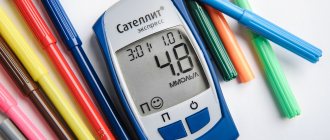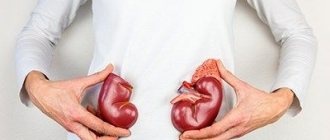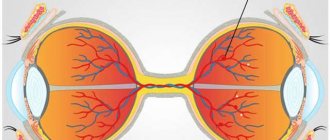Reasons for the development of the disease
After eating, nutrients enter the human blood, in particular glucose. The command for the transfer of glucose through cell membranes into cells is the hormone insulin. It is produced by the beta cells of the islets of Langerhans in the pancreas. If for some reason the glucose utilization mechanism is disrupted, diabetes mellitus occurs. The result of the disorder is a significant and chronic increase in blood sugar (glucose) levels.
Despite the different mechanisms of occurrence of the disease of different types, a number of reasons leading to it can be named:
- Genetic predisposition : the more blood relatives who have diabetes, the higher the risk of its occurrence.
- Obesity : Excess body weight has been found to significantly increase the risk of disease.
- Inflammatory processes : infectious and inflammatory diseases can lead to damage to the pancreas and disruption of its secretory function.
- Poisoning of the body with toxins and heavy metals : can also disrupt the secretory function of the pancreas, or disrupt the receptor sensitivity of cells to insulin.
- Inadequate nutrition and unhealthy lifestyle : can damage the body in general and glucose metabolism in particular.
- Alcoholism : affects the entire body, the pancreas in particular.
- Stress: can also cause a “breakdown” of carbohydrate metabolism; a severe stressful situation is especially dangerous.
- Age: One type of diabetes has another name, “senile.” In fact, it is not age that becomes the cause, but many other factors that lead to impaired glucose metabolism.
- Pregnancy: is a serious stress and can temporarily overload carbohydrate metabolism. After childbirth, the ability to metabolize glucose is usually restored.
Sweet disease from a hard life
Diabetes mellitus is a disease caused by a lack of insulin, a pancreatic hormone. Diabetes mellitus manifests itself in increased blood sugar levels (normal 3.3-5.5), the appearance of sugar in the urine, and metabolic disorders. Diabetes mellitus is classified into two types: Type I diabetes mellitus - insulin-dependent. The first type of diabetes mellitus develops when up to 90% of pancreatic cells die due to viral or autoimmune damage. As a result, insulin is not produced. Type I diabetes affects people at a young age. Type II diabetes mellitus is non-insulin dependent. The second type of diabetes mellitus develops as a result of impaired sensitivity of body tissue cells to insulin. Insulin is produced in the body, even in increased quantities, but cannot perform its functions, since the cells “do not listen to it.” Type II diabetes mellitus is hereditary. It usually affects people over 40 years of age, especially those who are prone to obesity. Symptoms and course The main symptoms of the development of diabetes mellitus are the appearance of severe thirst and an increase in the amount of urine (up to 3-5 liters per day). For diagnosis, a blood sugar test is performed. Type I diabetes develops rapidly. Its signs are sudden weight loss (up to 10-15 kg per month), weakness, fatigue, and the smell of acetone from the mouth. If treatment is not started in time, diabetic coma develops, which leads to death. In type II diabetes, the disease develops slowly. Characteristic symptoms develop gradually and can manifest themselves in the form of thirst, dry mouth, itching, and pustular skin lesions. Diabetic coma occurs extremely rarely. Complications of Diabetes Mellitus Diabetes mellitus has very serious complications. High blood sugar levels lead to the destruction of capillaries - microvessels in various organs, which disrupts their blood supply and functioning. As a result, cataracts can develop, hemorrhages occur in the retina of the eyes, and blindness occurs. Diabetes also affects the kidneys, which leads to the development of chronic renal failure and uremia. When capillaries in the vessels of the lower extremities are destroyed, trophic ulcers appear on the legs, and gangrene of the fingers and feet develops. Neuropathy may develop. Its symptoms are pain in the legs, followed by loss of skin sensation. Men develop impotence. Since patients suffering from diabetes mellitus have reduced body resistance to viral infections, genitourinary tract inflammation and tuberculosis may be associated with the disease. In diabetes mellitus, fat accumulates in the liver, resulting in fatty degeneration and cirrhosis of the liver. People with diabetes often experience a number of psychological problems. Some patients make a whole “cult” out of their illness, living in the concept: “I am a diabetic, my life is suffering.” This position not only worsens a person’s emotional state, but also complicates the treatment of the disease. Tendency to diabetes Three categories of people have a tendency to diabetes: Overweight people perceive everything that happens very sensitively, they often have mood swings. They tend to be good-natured and extroverted. But at the same time, they are self-centered, strive to attract attention to themselves and know how to manipulate other people. Sedentary people. Observations show that in the early stages of diabetes, in 80% of people, blood sugar levels can be normalized by increasing physical activity. 'Owls' are people with a disrupted circadian rhythm, those who prefer to stay awake at night. It is in the morning hours that the endocrine system puts the entire body in order. And if a person usually sleeps at this time, then over time the insulin production mechanism is disrupted. Risk factors for the development of diabetes mellitus from the position of academic medicine: abuse of refined carbohydrates; eating fatty foods; physical inactivity; overweight; daytime nap; stress; alcohol consumption. The most common factor leading to the development of diabetes mellitus is the abuse of refined carbohydrates, i.e. products containing white sugar and white flour (confectionery, baked goods). Refined carbohydrates do not provide any beneficial substances, but have a significant impact on blood sugar levels. When consuming carbohydrates, there is first a sharp rise in blood sugar, and then a sharp drop, with almost no stability in the level. Sudden jumps in sugar levels lead to the following problems: excess weight; cholelithiasis; diabetes mellitus type II; hormonal disorders; diseases of internal organs (for example, pancreatitis). Diabetes mellitus in children The development of diabetes mellitus in children is associated with a lack of love and excessive consumption of refined carbohydrates. Diabetes mellitus occurs in children when parents are constantly busy and do not pay attention to the child. Instead of love, communication and joint activities, they bribe the child with sweets. Sweets become a substitute for love. The child becomes addicted to sweets both physically and psychologically. For adults, alcohol becomes a similar substitute for love. Diet for diabetes If you have diabetes, diet is a must. Excluded from the diet: sugar; jam; syrups; confectionery and sweet bakery products; sweet cookies; grapes, dates; alcohol. Psychosomatic causes of diabetes mellitus Dr. Torsunov O.G. names two factors predisposing to the development of diabetes mellitus: depressed emotional state: resentment, apathy, mental antagonism towards other people; overwork at work, when a person is too strongly attached to the result of work and works too hard - either physically or intellectually. Scientists from the Psychosomatics Clinic of the University of Munich identify three main reasons for the development of diabetes: 1. Post-traumatic depression, that is, a person’s prolonged stay in a state of shock after a severe shock: the loss of a loved one, a debilitating divorce, etc. A person cannot let go of this situation, although it is already a thing of the past. 2. Chronic problems and stress in the family (for example, alcoholism or infidelity of a spouse). People have been suffering from the same problems for years, and do not dare to solve them radically. The hormonal system is very sensitive to the environment, its work depends on the emotional state of a person. A person feels a lack of love as emotional hunger, which he tries to fill with food. Against the background of emotional hunger, gluttony may occur, followed by obesity and prolonged hyperglycemia (increased blood sugar), which leads to depletion of the insular apparatus. Chronic stress in which a person lives is one of the most common causes of diabetes. To normalize blood sugar levels, a person first needs peace of mind. 3. Increased anxiety, which can manifest itself either as fear or rage. The state of the pancreas is especially negatively affected by the lack of stability and a feeling of panicky anticipation. In a state of anxiety, the body burns sugar very quickly, so a person feels the urge to eat sweets. Gradually, the habit of “healing” from negative emotions with the help of chocolate develops. A dependence on sweets appears, which results in impaired insulin production and the development of type II diabetes. Psychosomatic treatment of diabetes mellitus Treatment of diabetes mellitus is primarily psychological work. And above all, a person’s purposeful independent work on his condition. Let's list the mental states that need to be worked out in diabetes mellitus: A person wants other people to love him and pay attention to him. But at the same time he does not know how to show his love towards other people. The other side of this problem: a person considers himself unworthy, undeserving of love. Complications to the kidneys (a paired organ) indicate that a person does not know how to find agreement with other people and enters into conflict situations. Fatigue, fatigue accompanying diabetes mellitus, may indicate dissatisfaction with work (a person is busy with something other than his own business). Diabetic retinopathy, or degeneration of the blood vessels in the retina, (leading to blindness) is an indicator that a person cannot see the world with loving eyes. Psychotherapy and psychoself-regulation are necessary conditions in the treatment of diabetes mellitus. When the mental state is stabilized, somatic homeostasis (the state of the internal environment of the body) is also equalized. A sign of successful treatment is the absence of disease progression combined with an improvement in emotional state. Qualified medical care The Angarsk City Hospital No. 1 provides comprehensive treatment for diabetes mellitus: outpatient appointments are carried out in clinic No. 1 (Sewing Factory stop). You can make an appointment with an endocrinologist by calling the reception: (3955) 58-60-03 daily, from 7-30; During classes at the School of Diabetes Mellitus, patients learn the most optimal lifestyle for this disease (you can enroll in the School from an endocrinologist); specialized endocrinology beds operate in the therapeutic department of the hospital (a referral for inpatient treatment can be obtained from an endocrinologist or a local general practitioner).
Protasova Valentina Anatolyevna
Section: Healthy lifestyle
What types of diabetes are there?
According to the mechanism of impaired glucose metabolism, diabetes mellitus is divided into two types.
Diabetes mellitus type 1
If, for a number of reasons, the pancreas begins to produce insufficient amounts of the hormone or not produce it at all, a pathological condition classified as type 1 diabetes occurs.
Its second name is insulin-dependent diabetes. The causes of damage to the pancreatic tissue responsible for the synthesis of insulin may be different, but the mechanism of the disease boils down to one thing - the hormone is not produced.
Currently, toxins have been identified that destroy the secretory function of the gland, viral infections, bacterial pancreatitis, even autoimmune disorders. Pathology can occur even at a very young age. Type 1 diabetes in children is called juvenile diabetes.
The only method of therapy is injection of insulin preparations. This type is incurable, and taking the hormone becomes a lifelong necessity.
Diabetes mellitus type 2
For a number of reasons, target cells may become unresponsive to hormone molecules. As a result, the pancreas produces the required or even excess amount of the hormone, but its cells become unresponsive (resistant) to it. The result of this failure is the same - an increase in blood glucose levels.
Since the problem is not a lack of insulin, its administration does not affect the course of the disease. For this reason, this type of diabetes has another name: non-insulin dependent.
MODY-diabetes
MODY diabetes is caused by a genetic defect that interferes with the secretion of insulin by the beta cells of the islets of Langerhans in the pancreas. MODY diabetes is not very common - about 5% of diabetic patients have this form of the disease. The onset of the disease usually occurs at a fairly early age. This type of diabetes mellitus is treated with the use of insulin, but to achieve optimal blood glucose levels, the patient requires low doses of insulin. Compensation for this type of diabetes is achieved quite easily. Figuratively speaking, MODY diabetes occupies a “middle” position between type 1 and type 2 diabetes.
Other types of diabetes
The following atypical types of this disease can be distinguished:
- Diabetes in pregnant women (gestational). Against the background of serious hormonal changes during pregnancy, the regulation of glucose metabolism may be temporarily disrupted. After childbirth, the disease goes away.
- Immune (autoimmune) diabetes. Its causes and mechanism are not fully understood. It manifests itself in the production of antibodies to insulin, insulin receptors of cells or to the cells of the islets of Langerhans, responsible for the synthesis of the hormone.
- Genetic (hereditary). There are a number of hereditary syndromes that are accompanied by diabetes.
These types are quite rare.
Bibliography
- Alisheva, E.K. Methods for diagnosing insulin resistance / E.K. Alisheva, E.I. Krasilnikova, E.V. Shlyakhto // Arterial hypertension. - 2002. - No. 1. - P. 29-34.
- Vydrych, A.N. The state of some parts of the endocrine system in men with diabetic nephropathy / A.N. Vydrych, S.B. Shustov // Vestn. Ross. Military honey. acad. - 2008. - No. 1 (21). — P. 12-15.
- Danilishina, V.S. / V.S. Danylyshina, V.L. Kushnir // Ter. arch. - 1984. - No. 10. - P. 86-88.
- Kulikov, V.Yu. / V.Yu. Kulikov, L.I. Kolesnikova, L.V. Molchanov // Issue. honey. chemistry. - 1976. -T. 22, No. 5. - P. 617-620.
- Methods of biochemical research / ed. M.I. Prokhorova // - L., 1982. - 272 p.
- Perova, N.V. Metabolic syndrome: pathogenetic relationships and directions of correction / N.V. Perova, V.A. Metelskaya, R.G. Oganov // Cardiology. - 2001. - No. 3. - P. 27 - 32.
- Pokrovsky, A.A. Biochemical research methods in the clinic / A.A. Pokrovsky. - M.: 1969. - 85 p.
- Tvorogova, M.G. Insulin resistance and methods of its diagnosis / M.G. Tvorogova, K.N. Yaskova, I.E. Chazova // Laboratory Medicine - 2003 - No. 6. - P. 48 - 52.
- Lohr, E. W. Methoden der enzymatischen Analyze. / EW Lohr, HD Waller, HU Bergmeyer //Weinheim - 1974. - Bd 1. - P. 673.
- Reaven, GM Introduction. The role of insulin resistance in the pathogenesis and treatment of noninsulin - dependent diabetes mellitus. / GM Reaven //Amer. J. Med. - 1983. - Vol. 74. - P. 1-2.
Author:
Baktyshev Alexey Ilyich, General Practitioner (family doctor), Ultrasound Doctor, Chief Physician
Insulin and its role in the human body
Glucose is the main fuel for energy metabolism in the human body. After eating, it almost immediately enters the bloodstream and is transported to the cells of the entire body. In order for cells to accept glucose molecules and use them in their processes, it is necessary that the cell membrane receptors be activated by a specific polypeptide hormone - insulin.
The hormone is produced by the pancreas in the beta cells of the islets of Langerhans. If it is not produced, then glucose from the blood does not enter the cells and accumulates in the blood, and the sugar level increases accordingly. In this case, the body becomes exhausted, as the cells are deprived of their main source of energy. Then the body tries to use “reserve fuel” – fats and proteins. As a result, the patient may become extremely exhausted.
When insulin is not produced, it must be given by injection. If this is not done, the body will literally “eat itself.”
Main types of insulin
When the only option is to inject the hormone, it is important to choose the right medication.
Insulin preparations can be divided into the following types based on their origin:
- Porcine - the pork insulin molecule is almost identical in its amino acid sequence to the human insulin molecule. Produced from pig pancreas by extraction and purification. When administered, it functionally replaces human.
- Cattle insulin – is extracted from cattle material. The difference between bovine hormone and human hormone is significant and often causes allergic reactions.
- Genetically engineered - modified microorganisms are used for its production.
Now the best drugs are produced by modified microorganisms. Using DNA recombination, genes responsible for the production of insulin are inserted into them, and molecules are obtained - complete analogues of human ones. They do not cause allergies or immune reactions and are as effective as possible.
Classification by number of components
If a drug contains one type of hormone, it is called monotype. When different types of hormones are present, it is called combined.
Degree of purification of the drug
Insulin from natural sources (for example, pork) is obtained by purifying the raw material and isolating one fraction.
With standard purification, the so-called “traditional” is obtained. It contains many impurities and is less tolerated by patients.
With more thorough cleaning, the result is monopeak. It contains fewer impurities and has fewer side effects.
At the highest purification, a one-component product is obtained. It can be called the highest quality.









